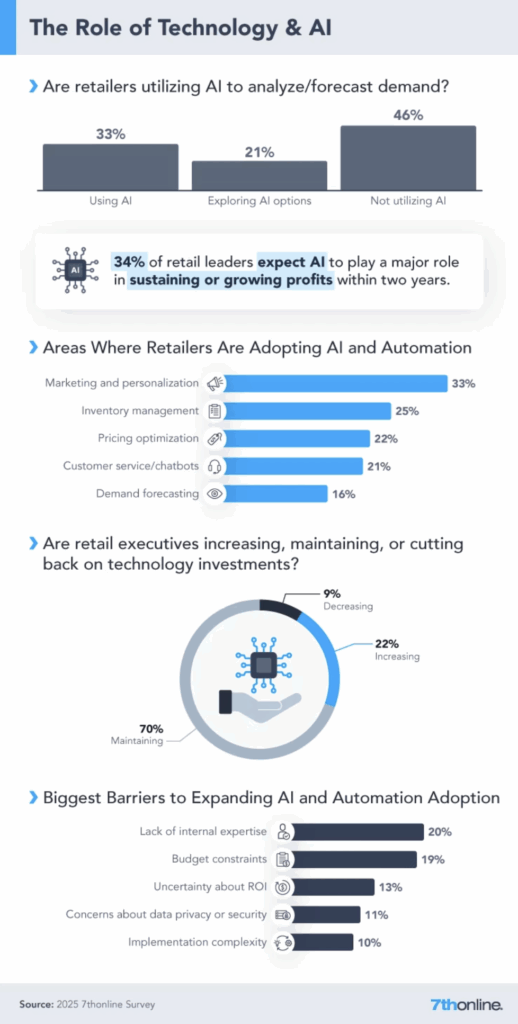
The retail industry is all about timing and shopper expectations that never stop evolving. The ability to predict what might happen is no longer enough; retailers need to know what to do next. That’s where prescriptive AI enters the picture. Not just as a powerful tool, but as the strategic backbone of smart allocation and retail success.
Retailers that still rely on manual planning or predictive analytics alone are at risk of falling behind. In 2023 alone, global retailers lost a staggering $1.77 trillion due to poor inventory management (IHL Group). While predictive AI can analyze past data to forecast trends, prescriptive AI goes further by recommending exactly what action to take to achieve optimal results. It’s the difference between saying, “We’re likely to run out of stock next week,” and “Ship 300 size mediums to Chicago by Thursday.”
According to a recent survey of 100+ retail executives about their retail strategy by 7thonline, 33% of retail executives are currently using AI to analyze/forecast demand. The move from predictive AI to prescriptive AI is a game-changing shift.

Why AI Matters in Retail
As artificial intelligence continues to develop, retailers are increasingly faced with the challenge, and the opportunity, to integrate AI into every step of their workflows in meaningful ways. But to truly unlock AI’s value, it’s important to understand the distinctions between different types of AI—in particular, prescriptive and predictive AI. Knowing how and when to apply each can make the difference between basic automation and transformative performance.
Today’s most visible AI applications often fall under the category of generative AI—think of ChatGPT writing a blog post or GitHub Copilot recommending code—these tools rely on large language models to generate output. They are not built to make decisions based on future possibilities.
Predictive AI in Retail Leads to Smarter Forecasting, Limited Action
Predictive AI is built specifically to forecast what is likely to happen based on patterns identified in historical data. It’s one of the most widely adopted AI tools in retail, helping brands anticipate demand, understand customer behavior and plan seasonal strategies. From identifying best-selling products to forecasting supply needs, predictive AI informs planning, but stops short of driving execution.
Some of the benefits of predictive AI for retailers include:
- Risk Mitigation – By identifying potential risks and operational vulnerabilities early, predictive AI helps retailers take preemptive action, improving supply chain resilience and cost control.
- Optimized Resource Allocation – Forecasting demand more accurately helps retailers avoid overstocking or understocking, leading to better inventory balance and reduced carrying costs.
- Personalized Customer Experiences – Predictive models enable tailored marketing and merchandising based on customer behavior, increasing satisfaction and driving conversions.
- Improved Product Development – Insights into trends and customer needs help brands launch more relevant products, better manage SKUs and refine future collections.
The challenge? Predictive AI might tell a retailer that outerwear sales will spike in October, but it won’t advise how many coats to ship, where to ship them or what sizes and colors are most likely to sell in each region. That kind of tactical guidance requires something more powerful.
Prescriptive AI: From Inventory Guesswork to Precision Execution
This is where prescriptive AI transforms retail strategy. Unlike predictive AI, prescriptive tools don’t just analyze trends, they recommend real-time, data-driven actions to achieve the best outcomes based on the brand’s needs and challenges. Prescriptive AI takes into account past sales, current stock levels, store performance and supply chain constraints to guide decisions at a granular level.
In inventory management, for example, prescriptive AI enables brands to dynamically allocate products across channels, optimize assortment mixes and make agile in-season decisions to preserve margins. It connects planning with execution, automatically and intelligently. Some of the benefits of prescriptive AI for retailers include:
- Optimized Operations – Prescriptive AI improves workflows by offering concrete recommendations for day-to-day tasks like allocation, replenishment and merchandising.
- Faster, More Confident Decision-Making – Retailers gain immediate, real-time insights that empower teams to act quickly and accurately in fast-changing market conditions.
- Increased Revenue and Margin – With improved sell-through, fewer markdowns and better alignment between supply and demand, prescriptive AI helps drive growth and reduce waste.
- Enhanced Customer Satisfaction – By ensuring the right product is in the right place at the right time, brands deliver better shopping experiences, driving loyalty and repeat purchases.
- Strategic Advantage – Prescriptive tools allow retailers to model scenarios, test responses and plan future strategies with more precision, giving them a significant edge in a crowded marketplace.
Prescriptive AI for Smarter Allocation and Fulfillment
Prescriptive AI is especially powerful when it comes to smart product allocation. Traditional allocation relies on rules and parameters including store size or historical averages. But retail today requires dynamic, demand-driven precision. With prescriptive AI, retailers can identify which stores need more of a specific SKU, which locations will underperform with certain products and when to shift inventory based on real-time sales velocity.
By automating complex planning decisions, prescriptive AI frees up teams to focus on strategy instead of spreadsheets—getting out of “Excel Hell”. Businesses see improved workflow efficiency, tighter supply chain coordination and more agility in responding to disruptions.
More importantly, prescriptive AI helps unify disconnected systems by bridging gaps between merchandising, planning, marketing and fulfillment. The result is a more synchronized, responsive retail organization.
Real-World Results: A $250M Fashion Brand Concept Case
To understand the impact of prescriptive AI in real terms, 7thonline ran an ROI analysis for a $250 million brand exploring our wholesale planning and allocation solution.
In the first year, without changes in production, the brand saw a projected $1.9 million boost in revenue, driven purely by better product placement. Alongside SG&A cost reductions, this delivered a 161% ROI. By year two, the brand reached full implementation and benefit realization. By year five, the cumulative benefit grew to $7.3 million, while total cost of ownership dropped to less than half its original value, delivering nearly 8X return on investment.
Faster insights. Smarter actions. Better performance.
AI has revolutionized how retailers analyze data by making it faster, more accurate and more intuitive. With intelligent analytics, businesses can move from reacting to problems to anticipating and solving them proactively.
Predictive AI identifies patterns and forecasts future trends, helping retailers make informed decisions. Prescriptive AI goes a step further, using those insights to recommend the best actions to optimize outcomes. Both are powerful, but serve different purposes. Retailers that understand when to use each can turn data into strategic advantage including boosting efficiency, accuracy and performance across their operations.



